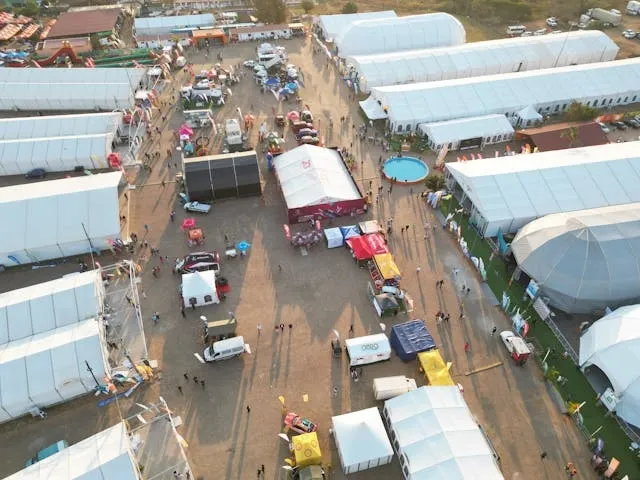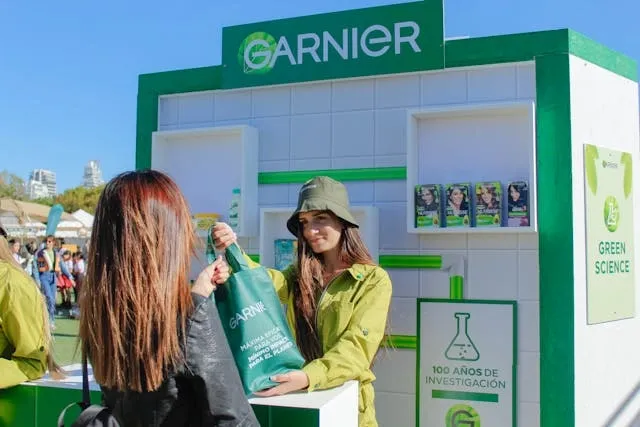How To Prepare For A Trade Show? (Booth Setup Tips, Staffing, And Budgeting)
Preparing for a trade show takes much more than simply showing up with a banner and a handshake. To succeed in this competitive environment, you need meticulous trade show planning, from booth design to post-event lead follow-up.
Whether this is your first time exhibiting or you’re a seasoned vendor, this guide offers comprehensive trade show advice to help you align efforts across staffing, booth setup, promotion, and goal setting. Prepare right to enjoy exceptional returns.

Key Takeaways
- Trade show preparation starts months in advance, involving goal-setting, budgeting, staffing, logistics, and more.
- You must set measurable objectives, train staff, create a professional presentation, manage costs, negotiate sponsorships, and more.
- Create a solid market plan that includes social media and research how to present yourself at a trade show for maximum impact.
- We supply high-quality custom table covers and a range of other bespoke products that you can use to enhance your impact at trade shows.
Table of contents
-
How To Prepare For A Trade Show?
-
How Should You Prepare Trade Show Staff And Team Members?
-
How Do You Budget And Manage Trade Show Logistics?
-
How Do You Handle Sponsorships And Vendor Communication?
-
How Do You Create A Marketing Plan For A Trade Show?
-
What Materials Should You Bring To Market Your Brand?
-
How Do You Generate Leads And Follow Up After The Trade Show?
-
How Do You Define And Align Trade Show Goals?
-
How Should You Present Yourself At A Trade Show?
How To Prepare For A Trade Show?
Learning how to prepare for a trade show begins with understanding that you are embarking on a multifaceted process that blends creativity, logistics, and business strategy. Trade show preparation should start at least 3-6 months before the event. With early planning, you can secure the best booth location, develop targeted campaigns, and train staff effectively.
If you are a first-time exhibitor, your focus should be on building awareness and gaining experience. Seasoned professionals, meanwhile, should work on refining past strategies and introducing innovations. Regardless of experience level, knowing how to plan a trade show is essential for generating leads and strengthening industry relationships.
Key elements of trade show planning include:
- Booth design
- Staffing
- Branding materials
- Shipping coordination
- Marketing
When you start planning for trade shows early and follow a clear roadmap, your efforts can yield real business growth. Work with us for affordable assets like custom trade show table covers to maximize your impact.

What Are The First Steps When Planning A Trade Show?
In the earliest stages of trade show planning, you should set clear, actionable objectives.
Success can come in many forms, such as:
- Lead generation
- Brand awareness
- Partnership development
- Product sales
The goals you set shape every subsequent decision.
After this, you should focus on budgeting. You will need to factor in booth rental, staff travel, marketing collateral, shipping, and promotional giveaways. Once you select the right event for you, register early and start thinking about trade show booth display ideas while coordinating travel logistics and initiating internal planning meetings.
Strong early-stage planning sets the tone for a successful experience. Lay the foundations for the rest of your preparation to proceed smoothly.
How Should You Prepare Trade Show Staff And Team Members?
Your staff are your brand ambassadors, so training and coordination are key components of trade show preparation. Start by choosing a team with strong communication skills, product knowledge, and professional appearance.
Once your team is selected, you should hold prep sessions. The goals of these are to:
- Align on messaging
- Prepare lead capture procedures
- Establish proper booth etiquette
When planning for trade shows, make sure your team understands the brand’s goals and knows how to answer FAQs, demonstrate products, and transition conversations towards conversion. Role-playing exercises can be really helpful to prepare your team for real interactions.
Make sure responsibilities are clearly assigned. You need someone to greet visitors, someone to present demos, and someone responsible for managing scheduling or giveaways. Booth success is a team effort, and this should be clear in your planning.
Looking for a personalized table runner to display at your trade show booth?
Work with us to create custom trade show table runners to enhance the aesthetic of tables in your booth and display key brand or product information for potential customers.
How Do You Budget And Manage Trade Show Logistics?
As mentioned, budgeting is one of the most critical aspects of your trade show planning. From the outset, you should list all the expected costs. These are likely to include:
- Registration fees
- Booth design
- Shipping
- Hotel
- Meals
- Staff wages
- Marketing materials
In your trade show preparation, you should also account for hidden expenses like electricity, carpet rental, internet access, and insurance. A well-structured budget will help to prevent overspending and ensure no essential item goes overlooked.
If you’re learning how to plan a trade show for the first time, consider using project management tools and explore trade show booth ideas for small budgets. Compare shipping vendors and be aware of handling charges imposed by convention centers. Trade show advice often emphasizes logistics - even a small oversight is likely to impact the entire experience.

How Much Does It Cost To Exhibit At A Trade Show?
The cost of exhibiting at a trade show can range from a few thousand to tens of thousands of dollars, depending on the scale of the event. Booth space is often the largest expense, and it can range from $2,000 to $10,000.
Trade show preparation should also account for custom booth designs. The cost of things like custom neon lights and other aspects can add up - you may end up spending another $5,000 to $15,000 on your booth. And travel and accommodation costs may easily total $1,000 to $2,000 per person.
Additional costs include:
- Print materials
- Branded merchandise
- Promotional campaigns
Those planning for trade shows should look for early registration discounts or smaller regional events where fees are lower. It can help to share a booth with a partner brand for mutual cost savings.
How Do You Handle Sponsorships And Vendor Communication?
Sponsorships can elevate your brand visibility and offset trade show costs. As part of your trade show preparation, identify sponsorship packages that include benefits like logo placement, featured listings, or sponsored speaking slots.
You may be able to negotiate terms and explore bundles by reaching out to event organizers early. Sponsorship can also include:
- Product placements
- Branded charging stations
- Event lanyards
When it comes to vendor communication, proactive engagement is crucial. Stay in regular contact with the suppliers handling your booth materials, digital assets, or shopping needs as you prepare. Confirm timelines and address potential delays well in advance for seamless execution with no surprises.
Branded booth accessories can be a great way to elevate your brand presence. With our online service, you can create and order custom trade show table covers with logos to elevate your visual identity and create a cohesive look.
Design optimized table covers for 6-foot trade show tables
Get the right branded look and attract attention to your booth with custom 6-foot table covers for trade shows. We enable you to choose the size and color and add your logo.
Explore optionsHow Do You Create A Marketing Plan For A Trade Show?
Your marketing strategy can make or break your trade show success. The first step is to identify your target audience and craft a compelling message tailored to their needs. From here, you can segment your strategy into three phases: pre-show promotion, in-show engagement, and post-show follow-up.
- Pre-show: In this phase, crease buzz with email campaigns, social media teasers, and exclusive offers.
- In-show: Marketing here should focus on attention-grabbing visuals, interactive demos, and meaningful conversations.
- Post-show: Send thank-you emails, follow up on leads, and post highlights.
Planning for trade shows also includes setting up lead capture tools and scheduling social media content. Incorporate trade show marketing ideas like leveraging influencer partnerships or offering exclusive giveaways to drive booth traffic.
To understand how to plan a trade show, you need to think beyond the booth to create an experience.
How Should You Use Social Media At Trade Shows?
Social media plays a key role in trade show planning. The impact of social media on trade shows is that it expands your reach before, during, and after the event. Here are some tips:
- Before the show: Post teasers about your booth, products, or giveaways. Use event-specific hashtags and tag the official event account.
- During the show: Post live updates, Instagram reels, LinkedIn stories, and behind-the-scenes content to keep followers engaged.
- After the show: Share highlights and thank attendees.
Both during and after the show, encourage visitors to share their experience using your hashtag or tagging your brand. Planning for trade shows should include a comprehensive social media schedule coordinated with your marketing team.
Trade show advice from seasoned marketers confirms that consistent, high-quality content helps build brand awareness and boost booth traffic.
What Materials Should You Bring To Market Your Brand?
Bringing the right marketing materials is another essential part of trade show preparation. It is essential to have a strong mix of print and digital assets, aligned with your brand’s voice and message.
Here are some essentials:
- Business cards
- Brochures
- Flyers
- Product catalogs
- Banners
It can be helpful to incorporate QR codes on printed materials for seamless digital engagement.
When you plan for trade shows, explore the best trade show giveaway ideas like pens, tote bags, or USB drives. These are all useful items that can be branded to keep you top of mind. Furthermore, a branded tablecloth or pop-up display enhances visual appeal and ensures a polished booth setup.
Captivate visitors with ideas like demo stations, video loops, and digital presentations. Planning a trade show involves preparing materials that are informative and attractive, and you should keep branding cohesive across all items.
Need a larger customized cover for your trade show table to make an impact?
With a range of sizes available, create custom 8-foot table covers for trade shows or choose different dimensions to optimize the look of your booth and make the right impression.
How Do You Generate Leads And Follow Up After The Trade Show?
Lead generation is one of the primary reasons businesses attend trade shows, so you must prepare for a trade show with a solid lead capture strategy. Tools like badge scanners, digital forms, and CRM apps can help collect attendee information efficiently.
During the event, qualify your leads by asking strategic questions that gauge interest. After the show, follow-up promptly with personalized messages. Prepare pre-written emails or outreach sequences segmented by different lead types (warm, cold, or hot prospects). A strong post-event follow-up plan is essential for maximizing your ROI.
Trade show advice from sales professionals stresses the importance of timely engagement. If you create a custom vinyl banner with a QR code, follow up quickly with the leads it generates for maximum impact.
How Do You Define And Align Trade Show Goals?
A critical, but often overlooked, part of trade show planning is defining and aligning your goals with broader business objectives. Start by identifying what you hope to achieve, whether it be brand exposure, product launches, customer acquisition, market research, or anything else.
With these goals, you have the basis to guide every aspect of trade show preparation. Make your objective SMART:
- Specific
- Measurable
- Achievable
- Relevant
- Time-bound
When you plan for trade shows, your goals should be communicated across your team so everyone works in tandem. 88% of businesses exhibit at trade shows to raise awareness of their brand, and trade show advice consistently highlights the importance of reviewing performance metrics after the event.
Clear benchmarks are important when planning a trade show to drive focused execution and enable you to justify your investment.

Customize your tablecloth with any colors and design elements for trade shows
With our online service, you can create custom print-on-demand tablecloths that add style and brand impact to your tables, ensuring visitors can see what you want them to.
Get startedHow Should You Present Yourself At A Trade Show?
Personal presentation is a powerful element in trade show preparation. Everyone on your team needs to understand that they are representing your brand in both appearance and conduct. Dress in professional, coordinated attire that reflects your industry and company image.
Ideas for this include:
- Branded polos
- Formal business wear
- Thematic uniforms
Beyond dress, elements like posture, eye contact, and body language help communicate confidence and approachability. When you plan for trade shows, your team should be well-versed in how to greet attendees, initiate conversations, and handle objections with professionalism.
Your custom wrinkle-free trade show table covers may attract visitors, but it is active engagement that will keep them there. Smile, be enthusiastic, and listen attentively to leave lasting impressions.
Frequently Asked Questions About How To Prepare For A Trade Show
How To Prepare For A Trade Show?
Start early - 3-6 months in advance is ideal. Define your goals, budget, target audience, and key messages, and be proactive to plan a trade show effectively.
How Do You Set Up A Trade Show Table Effectively?
Start with a clean, branded table cover and arrange your materials in a way that is inviting and uncluttered. Vertical displays, product samples, business cards, and digital assets are all helpful.